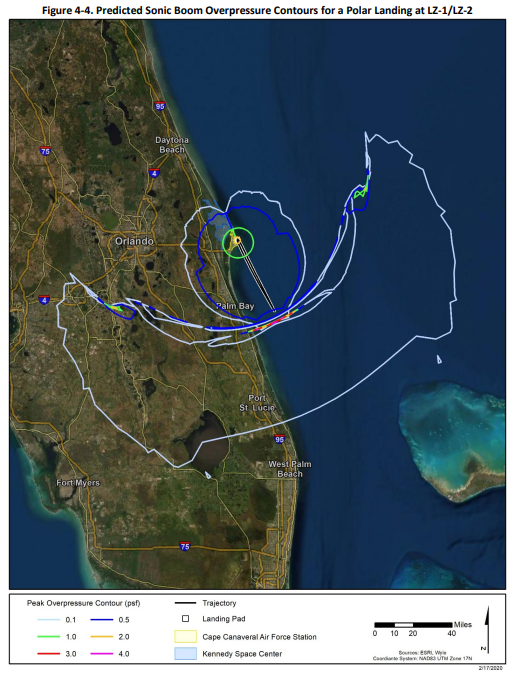Expect rocket rumbles and sonic booms this week with SpaceX launch and landings
Update: (Thursday, July 27) SpaceX has delayed the Falcon Heavy launch of the Jupiter 3 EchoStar satellite from Kennedy Space Center until Friday, July 28, at 11:04 p.m. EDT due to additional time needed for vehicle checkouts.
Wednesday night will be a long one for Space Coast residents unaccustomed to middle-of-the-night launches and double booster landings.
At Kennedy Space Center, SpaceX teams are gearing up for the overnight launch of a triple-core Falcon Heavy rocket between 10 p.m. EDT Wednesday, July 26, and 1 a.m. Thursday, July 27. If the rumble of 27 Merlin engines at liftoff isn't enough to wake residents, then window-rattling, low-frequency sonic booms generated by tandem booster landings at Cape Canaveral Space Force Station almost certainly will be.
As if that isn't enough action for the week, SpaceX is set to fly another Falcon 9 with more Starlink internet satellites about 24 hours later, overnight Thursday, from the Cape.
Falcon Heavy launch (and landings) up first

Set to liftoff from pad 39A, essentially three Falcon boosters strapped together comprise SpaceX's 230-foot Falcon Heavy, which is capable of producing nearly 5 million pounds of thrust. The heavy-class rocket is slated to loft the Jupiter 3 communications satellite for EchoStar, the largest commercial communications satellite ever built.
Jupiter 3, built by Maxar for Hughes Network Systems, is designed to deliver HughesNet broadband internet to rural and remote locations. It's roughly the size of a school bus and weighs in around nine tons. With its solar arrays fully deployed, it nearly matches the wingspan of a commercial airliner.

According to Hamid Akhavan, CEO of Hughes's parent company EchoStar, Jupiter 3 will join a fleet high above Earth in geostationary orbit "to serve more customers, especially where cable and fiber can't."
HughesNet currently boasts more than a million customers across North and South America. The addition of the Jupiter 3 satellite should increase that capacity by hundreds of thousands more.
Project Kuiper: Amazon to build $120 million Kuiper satellite processing facility at KSC
What is a sonic boom?

About three minutes into Falcon Heavy's flight, the side boosters will shut down and simultaneously separate from the center booster, which will continue on to help push the Jupiter 3 satellite to geostationary orbit.
Just after separation, the side boosters will somersault and push back toward the Cape, generating powerful sonic booms on the way down. Eight to nine minutes after liftoff, spectators should expect the somewhat rare occurrence of a twin booster touchdown at the Cape's Landing Zones 1 and 2.
Rocket launch schedule: Upcoming Florida launches and landings
The largely harmless – but oftentimes startling – sonic booms occur when a vehicle crosses the speed-of-sound threshold. They only last a fraction of a second but can be heard within a 100-mile radius depending on trajectory, humidity, cloud cover, wind direction, and more.
Each Falcon 9 rocket generates a triple boom on its way back for landing, though by the time it reaches spectators, it sounds more like a single boom, and in the case of a Falcon Heavy double booster landing, two slightly separated booms.
Approximately eight minutes after launch, Falcon Heavy's side boosters will return to Earth and land on Landing Zones 1 and 2 pic.twitter.com/rI1Cv9EBzy
— SpaceX (@SpaceX) July 24, 2023
The shape, size, and weight of the aircraft or rocket also influence sonic booms, according to NASA. The loudest sonic boom will be directly underneath the aircraft or rocket and decreases with distance from the flight path.
Not all missions are eligible for return to landing site, or RTLS, since enough fuel needs to be left over after launching heavier payloads. Such is the case for Falcon Heavy's center core booster with this mission.
Extra power to push the heavy payload to a high orbit means there won't be enough fuel left over to attempt a landing of any sort for the center booster. Instead, it will be expended into the Atlantic Ocean and SpaceX teams will not attempt a recovery.
Falcon 9 Starlink mission set for late Thursday liftoff
At the Cape, another batch of Starlink internet satellites is set to fly on a Falcon 9 before the weekend.
That mission, dubbed Starlink 6-7, is set to lift off Thursday, July 27, between 10:04 p.m. EDT and 12:44 a.m. Friday, July 28, from Launch Complex 40.
All told, SpaceX has sent nearly 5,000 of the satellites to orbit since first the first operational launches began in 2019. The massive constellation, which operates about 340 miles above Earth, helps provide services not only to remote and hard-to-reach destinations but also to boats, planes, and recreational vehicles for residential, government, and commercial customers. More than 1.5 million customers are subscribed to Starlink internet.
Look for FLORIDA TODAY's live launch coverage of both missions to begin 90 minutes before the liftoff at https://www.floridatoday.com/space/.
For the latest, visit floridatoday.com/launchschedule.
Contact Jamie Groh at JGroh@floridatoday.com and follow her on Twitter at @AlteredJamie.
Launch Wednesday, July 26
Company / Agency: SpaceX for Hughes Network Systems
Rocket: SpaceX Falcon Heavy
Location: Pad 39A at Kennedy Space Center
Launch Window: 11:04 p.m. EDT on Wednesday, July 26, to 12:43 a.m. EDT Thursday, July 27
Trajectory: East-Northeast
Weather: 85% "go"
Landing: Landing Zones 1 and 2 at Cape Canaveral Space Force Station; the center core is expendable
Live coverage: Starts 90 minutes before liftoff at floridatoday.com/space
About: SpaceX will launch a triple-core Falcon Heavy rocket from Kennedy Space Center in Florida with the JUPITER 3 communications satellites built by Maxar to deliver more broadband capacity and higher speed connectivity services to Hughes Network Systems customers across North and South America.
This article originally appeared on Florida Today: SpaceX Falcon Heavy launch to bring sonic booms to the Space Coast


